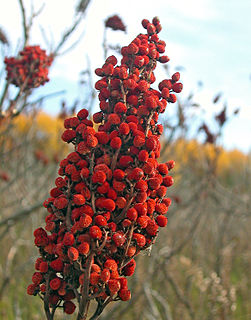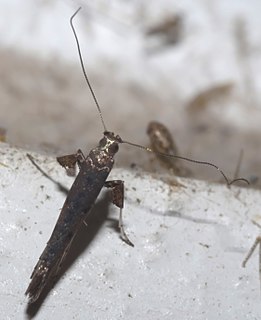
Toxicodendron is a genus of flowering plants in the sumac family, Anacardiaceae. It contains trees, shrubs and woody vines, including poison ivy, poison oak, and the lacquer tree. All members of the genus produce the skin-irritating oil urushiol, which can cause a severe allergic reaction. The generic name is derived from the Greek words τοξικός (toxikos), meaning "poison," and δένδρον (dendron), meaning "tree". The best known members of the genus in North America are poison ivy (T. radicans), practically ubiquitous throughout most of eastern North America, and western poison oak, similarly ubiquitous throughout much of the western part of the continent.

Sumac, also spelled sumach, is any one of about 35 species of flowering plants in the genus Rhus and related genera in the family Anacardiaceae. It grows in subtropical and temperate regions throughout the world, especially in East Asia, Africa, and North America.

Radioisotope heater units (RHU) are small devices that provide heat through radioactive decay. They are similar to tiny radioisotope thermoelectric generators (RTG) and normally provide about one watt of heat each, derived from the decay of a few grams of plutonium-238—although other radioactive isotopes could be used. The heat produced by these RHUs is given off continuously for several decades and, theoretically, for up to a century or more.

Rhus typhina, the staghorn sumac, is a species of flowering plant in the family Anacardiaceae, native to eastern North America. It is primarily found in southeastern Canada, the northeastern and midwestern United States, and the Appalachian Mountains, but it is widely cultivated as an ornamental throughout the temperate world.

Tanjong Rhu is a subzone within the planning area of Kallang, Singapore, as defined by the Urban Redevelopment Authority (URA). The perimeter of Tanjong Rhu is made up of Nicoll Highway in the north; Mountbatten Road and Fort Road in the east; East Coast Parkway (ECP) in the south; as well as Marina Channel and Kallang Basin in the west. Tanjong Rhu is the largest in terms of physical area among the nine subzones that make up Kallang.

Rhu is a village and historic parish on the east shore of the Gare Loch in Argyll and Bute, Scotland.

Gracillariidae is an important family of insects in the order Lepidoptera and the principal family of leaf miners that includes several economic, horticultural or recently invasive pest species such as the horse-chestnut leaf miner, Cameraria ohridella.
Federal Route 111, or Jalan Tanjung Rhu, is a major federal road in Langkawi Island, Kedah, Malaysia. The Kilometre Zero of Federal Route 111 starts at Tanjung Rhu.

Rhus coriaria, commonly called Sicilian sumac, tanner's sumach, or elm-leaved sumach, is a deciduous shrub to small tree in the cashew family Anacardiaceae. It is native to southern Europe and western Asia. The dried fruits are used as a spice, particularly in combination with other spices in the mixture called za'atar.

Rhus chinensis, the Chinese sumac, or nutgall tree, is a shrub or small tree in the genus Rhus. The plant is common in East and South Asia.

Caloptilia coruscans is a moth of the family Gracillariidae. It is known from south-western Europe and Thrace.
Corethrovalva paraplesia is a moth of the family Gracillariidae. It is known from South Africa.
Caloptilia rhusina is a moth of the family Gracillariidae. It is known from South Africa.
Eteoryctis deversa is a moth of the family Gracillariidae. It is known from India, Japan, Korea, the Russian Far East and Taiwan.
Caloptilia recitata is a moth of the family Gracillariidae. It is known from China, Hong Kong, India, Japan and Nepal.
Caloptilia rhois is a moth of the family Gracillariidae. It is known from China, Hong Kong, Japan and Korea.
Phyllonorycter leucaspis is a moth of the family Gracillariidae. It is known from Namibia. The habitat consists of richly vegetated valleys between 1,600 and 1,900 meters elevation dominated by Acacia hereroensis, Dombeya rotundifolia and Rhus species.
Caloptilia belfragella is a moth of the family Gracillariidae. It is known from Quebec and the United States.

Caloptilia rhoifoliella is a moth of the family Gracillariidae. It is known from Bermuda, Canada the United States.










